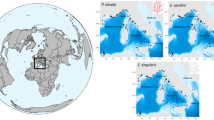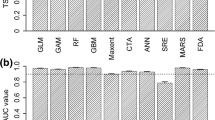Abstract
Global climate change (GCC) is expected to lead to massive loss of global biodiversity in the alpine regions of mountain ranges. Studies on the potential effects of GCC on low mountain areas remain sparse, however, despite the high conservation value of these areas as biodiversity refugia. We chose a species distribution modeling approach to assess potential GCC impacts on the future distributions of montane freshwater invertebrates under two different greenhouse gas scenarios and three averaged general circulation models. For this, ensemble models consisting of six algorithms [generalized linear model (GLM), generalized boosted model (GBM), generalized additive model (GAM), classification tree analysis (CTA), artificial neural networks (ANN), and multivariate adaptive regression splines (MARS)] were applied to project areas of 23 cold-stenothermic aquatic insects from montane regions of Central Europe. We found an average loss of 70–80% of the potential distribution for the study species until 2080, depending on the underlying Intergovernmental Panel on Climate Change scenario. Species distribution ranges below 1000 m above sea level were found to decrease by up to ~96% according to the severest greenhouse gas emission scenario. While the Alps remain the single main refugium under the A2a greenhouse gas emission scenario, the more moderate climate scenario B2a shows fragmented potential persistence of montane insects in some low mountain ranges. The results show that montane freshwater assemblages in low mountain ranges are particularly threatened by ongoing GCC. As vertical dispersal is limited by elevational restriction, low mountain ranges may act as summit traps under GCC. We thus propose that GCC will lead to the extinction of several species and unique genetic lineages of postglacial relict species, resulting in a significant decline in Central European fauna.




Similar content being viewed by others
Abbreviations
- GCC:
-
Global climate change
- GCM:
-
General circulation model
- IPCC:
-
Intergovernmental Panel on Climate Change
- SDM:
-
Species distribution model
- a.s.l.:
-
Above sea level
References
Akaike H (1973) Information theory and an extension of the maximum likelihood principle. In: Petrov BN, Csaki F (eds) Proceedings of the second international symposium on information theory, Budapest, pp 267–281
Araújo MB, Guisan A (2006) Five (or so) challenges for species distribution modelling. J Biogeogr 33:1677–1688
Araujo MB, Whittaker RJ, Ladle RJ et al (2005) Reducing uncertainty in projections of extinction risk from climate change. Global Ecol Biogeogr 14:529–538
Asch K (2005) The 1:5 Million International Geological Map of Europe and Adjacent Areas. Bundesanstalt für Geowissenschaften und Rohstoffe (BGR), Hannover
Bässler C, Müller J, Hothorn T et al (2010) Estimation of the extinction risk for high-montane species as a consequence of global warming and assessment of their suitability as cross-taxon indicators. Ecol Indi 10:341–352
Beniston M (2006) Mountain weather and climate: a general overview and a focus on climatic change in the Alps. In: Lami A, Boggero A (eds) Ecology of high altitude aquatic systems in the Alps, Hydrobiol 562:3–16
Braukmann U (1987) Zoozönologische und saprobiologische Beiträge zu einer allgemeinen regionalen Bachtypologie. Fundam Appl Limnol Arch Hydrobiol 26:1–355
Collier KJ, Smith BJ (1997) Dispersal of adult caddisflies (Trichoptera) into forests alongside three New Zealand streams. Hydrobiologica 361:51–65
CSF (2010) Centre Suisse de Cartographie de la Faune. Data accessed February 2010
Diaz HF, Grosjean M, Graumlich L (2003) Climate variability and change in high elevation regions: past, present and future. Climatic Change 59:1–4
Dirnböck T, Essl F, Rabitsch W (2011) Disproportional risk for habitat loss of high-altitude endemic species under climate change. Glob Chang Biol 17:990–996
Domisch S, Jähnig SC, Haase P (2011) Climate-change winners and losers: stream macroinvertebrates of a submontane region in Central Europe. Freshwater Biol. doi:10.1111/j.1365-2427.2011.02631.x
Earth Resources Observation and Science Center (1996) GTOPO30 database from the USGS (United States Geological Survey). Eros Data Center, USA. http://eros.usgs.gov cited 24 Jan 2010
Ellenberg H (1996) Vegetation Mitteleuropas mit den Alpen in ökologischer dynamischer und historischer Sicht. Verlag Eugen Ulmer, Stuttgart
Engelhardt CHM, Pauls SU, Haase P (2008) Population genetic structure of the caddisfly Rhyacophila pubescens, Pictet 1834, north of the Alps. Fundam Appl Limnol Arch Hydrobiol 173:165–175
Environmental Systems Research Institute (2006) ArcGIS 9.3. Environmental Systems Research Institute, Redlands
Essl F, Staudinger M, Stöhr O et al (2009) Distribution patterns, range size and niche breadth of Austrian endemic plants. Biol Conserv 142:2547–2558
Fielding AH, Bell JF (1997) A review of methods for the assessment of prediction errors in conservation presence/absence models. Environ Conserv 24:38–49
Flato GM, Boer GJ, Lee WG et al (2000) The Canadian centre for climate modelling and analysis global coupled model and its climate. Clim Dyn 16:451–467
GBIF (2007) Global Biodiversity Information Facility: free and open access to biodiversity data http://www.gbif.org. Data accessed February 2010
Gordon HB, O’Farrell SP (1997) Transient climate change in the CSIRO coupled model with dynamic sea ice. Mon Wea Rev 125:875–907
Gordon C, Cooper C, Senior CA et al (2000) The simulation of SST, sea ice extents and ocean heat transports in a version of the Hadley Centre coupled model without flux adjustments. Clim Dyn 16:147–168
Grabher G, Gottfried M, Pauli H (1994) Climate effects on mountain plants. Nature 369:448
Haase P (1999) Zoozönosen, Chemismus und Struktur regionaler Bachtypen im niedersächsischen und nordhessischen Bergland. Dissertation, Universität Gesamthochschule Kassel
Habel JC, Schmitt T, Meyer M et al (2010) Biogeography meets conservation: the genetic structure of the endangered lycaenid butterfly Lycaena helle (Denis & Schiffermüller, 1775). Biol J Linn Soc 101:155–168
Heino J, Virkkala R, Toivonen H (2009) Climate change and freshwater biodiversity: detected patterns, future trends and adaptations in northern regions. Biol Rev 84:39–54
Hering D, Schmidt-Kloiber A, Murphy J et al (2009) Potential impact of climate change on aquatic insects: A sensitivity analysis for European caddisflies (Trichoptera) based on distribution patterns and ecological preferences. Aquat Sci 71:3–14
Hewitt G (2000) The genetic legacy of the quaternary ice ages. Nature 405:907–913
Hickling R, Roy DB, Hill JK et al (2006) The distributions of a wide range of taxonomic groups are expanding polewards. Glob Chang Biol 12:450–455
Hijmans RJ, Cameron SE, Parra JL et al (2005a) Very high resolution interpolated climate surfaces for global land areas. Int J Climatol 25:1965–1978
Hijmans RJ, Guarino L, Jarvis A et al. (2005b) DIVA-GIS Version 5.2 manual
IPCC (2007a) Working group II report “impacts, adaptation and vulnerability”. In: Parry ML, Canziani OF, Palutikof JP, van der Linden PJ, Hanson CE (eds) Contribution of working group ii to the fourth assessment report of the intergovernmental panel on climate change, 2007. Cambridge University Press, Cambridge, pp 976
IPCC (2007b) Summary for policymakers. In: Solomon S, Quin D, Manning M, Chen Z, Marquis M, Averyt KB, Tignor M, Miller HL (eds) Climate change 2007: the physical science basis. Contribution of working group i to the fourth assessment report of the Intergovernmental panel on climate change. Cambridge University Press, Cambridge, pp 1–18
Kubow KB, Robinson CT, Shama LNS et al (2010) Spatial scaling in the phylogeography of an alpine caddisfly, Allogamus uncatus, within the central European Alps. J N Am Benthol Soc 29:1089–1099
Küttner R, Hohmann M, Plesky B et al (2008) Zur Verbreitung und Ökologie von Brachyptera braueri (Klapálek, 1900) (Insecta: Plecoptera) in Mitteldeutschland unter Berücksichtigung weiterer Plecoptera-Arten des zeitigen Frühjahres. Lauterbornia 63:31–50
Lehrian S, Bálint M, Haase P, Pauls SU (2010) Genetic population structure of an autumn-emerging caddisfly with inherently low dispersal capacity and insights into its phylogeography. J N Am Benthol Soc 29:1100–1118
Lomolino MV (2001) Elevation gradients of species-density: historical and prospective views. Glob Ecol Biogeogr 10:3–13
MacNeale KH, Peckarsky BL, Likens GE (2005) Stable isotopes identify dispersal patterns of stonefly populations living along stream corridors. Freshwater Biol 50:1117–1130
Parmesan C (2006) Ecological and Evolutionary Responses to Recent Climate Change. Annu Rev Ecol Evol Syst 37:637–660
Parmesan C, Yohe G (2003) A globally coherent fingerprint of climate change impacts across natural systems. Nature 421:37–42
Pauli H, Gottfried M, Reiter K et al (2007) Signals of range expansion and contractions of vascular plants in the high Alps: observations (1994–2004) at the GLORIA master site Schrankvogel, Tyrol Austria. Glob Chang Biol 13:147–156
Pauls SU, Lumbsch HT, Haase P (2006) Phylogeography of the montane caddisfly Drusus discolor: evidence for multiple refugia and periglacial survival. Mol Ecol 15:2153–2169
Petersen I, Masters Z, Hildrew AG et al (2004) Dispersal of adult aquatic insects in catchments of differing land use. J Appl Ecol 41:934–950
Pope VD, Gallani ML, Rowntree PR et al (2000) The impact of new physical parameterizations in the Hadley Centre climate model: HadAM3. Clim Dyn 16:123–146
Randin CF, Engler R, Normand S et al (2009) Climate change and plant distribution: local models predict high-elevation persistence. Glob Chang Biol 15:1557–1569
Riordan EC, Rundel PW (2009) Modelling the distribution of a threatened habitat: the California sage scrub. J Biogeogr 36:2176–2188
Root TL, Price JT, Hall KR et al (2003) Fingerprints of global warming on wild animals and plants. Nature 421:57–60
Sala OE, Chapin FS, Armesto JJ et al (2000) Global biodiversity scenarios for the Year 2100. Science 287:1770–1774
Schröter D, Cramer W, Leemans R et al (2005) Ecosystem service supply and vulnerability to global change in Europe. Science 310:1333–1337
Stockwell DRB, Peterson AT (2002) Effects of sample size on accuracy of species distribution models. Ecol Modelling 148:1–13
Swets JA (1988) Measuring the accuracy of diagnostic systems. Science 240:1285–1293
Taubmann J, Theissinger K, Feldheim KA et al (2011) Modelling range shifts and assessing genetic diversity distribution of the montane aquatic mayfly Ameletus inopinatus in Europe under climate change scenarios. Conserv Genet 12:503–515
Thomas CD, Cameron A, Green RE et al (2004) Extinction risk from climate change. Nature 427:145–148
Thuiller W (2003) BIOMOD—optimizing predictions of species distributions and projecting potential future shifts under global change. Glob Change Biol 9:1352–1362
Thuiller W (2007) Climate change and the ecologist. Nature 448:550–552
Thuiller W, Lavorel S, Araújo MB et al (2005) Climate change threats to plant diversity in Europe. Proc Natl Acad Sci USA 23:8245–8250
Thuiller W, Lafourcade B, Engler R et al (2009) BIOMOD—a platform for ensemble forecasting of species distributions. Ecography 32:369–373
Ujvárosi L, Bálint M, Schmitt T et al (2010) Divergence and speciation in the Carpathians area: patterns of morphological and genetic diversity of the crane fly Pedicia occulta (Diptera: Pediciidae). J N Am Benthol Soc 29:1075–1088
Walther GR, Post E, Convey P et al (2002) Ecological responses to recent climate change. Nature 416:389–395
Wasson JG, Chandesris A, Garcia A et al (2007) Relationships between ecological and chemical status of surface waters. European Hydro- Ecoregions. Cemagref, Lyon, p 43
Wilcock HR, Nichols RA, Hildrew AG (2003) Genetic population structure and neighbourhood population size estimates of the caddisfly Plectrocnemia conspersa. Freshwater Biol 48:1813–1824
Wilson RJ, Gutiérrez D, Gutiérrez J et al (2005) Changes to the elevational limits and extent of species ranges associated with climate change. Ecol Lett 8:1138–1146
Winterbourn MJ, Cadbury S, Ilg C et al (2007) Mayfly production in a New Zealand glacial stream and the potential effect of climate change. Hydrobiol 603:211–219
Acknowledgments
We are grateful to J. Böhmer, R. Brettfeld, B. Eiseler, F. Fischer, A. Haybach, R. Küttner, S. Lehrian, A. Lorenz, W. Mey, P. Neu, S. U. Pauls, T. Pitsch, B. Robert, R. Semmler-Elpers, K. Theissinger, A. Weinzierl, and P. Zwick for kindly providing the data points for the analyzed species. Thanks to M. Bálint and S. U. Pauls for scientific support. This study was funded by the Hessian initiative for scientific and economic excellence [Landes-Offensive zur Entwicklung wissenschaftlich-ökonomischer Exzellenz (LOEWE)] of the Hessian Ministry of Higher Education, Research, and the Arts.
Author information
Authors and Affiliations
Corresponding author
Rights and permissions
About this article
Cite this article
Sauer, J., Domisch, S., Nowak, C. et al. Low mountain ranges: summit traps for montane freshwater species under climate change. Biodivers Conserv 20, 3133–3146 (2011). https://doi.org/10.1007/s10531-011-0140-y
Received:
Accepted:
Published:
Issue Date:
DOI: https://doi.org/10.1007/s10531-011-0140-y




